When you are done shooting, it is important to decock your pistol. This means that you will safely lower the hammer on the gun. Failing to do so can result in an accidental discharge, which could cause serious injury or death.
In this guide, we will teach you how to properly and safely decock your pistol. We will also discuss how to decock a 1911 specifically.
So, whether you are a beginner or experienced shooter, read on for all the information you need!
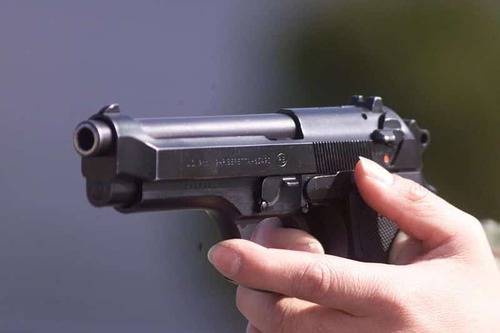
TABLE OF CONTENTS
What does decock mean?
The word decocking is used to describe the process of safely lowering the hammer on a gun. This is typically done by engaging the safety, which will prevent the gun from firing even if the trigger is pulled. Once the safety is engaged, you can then lower the hammer slowly and carefully. This process should only be done when you are finished shooting and are ready to store or holster your gun.
Decocking levers and safety/decockers are the two varieties that they come in.
- A decocking lever is a device that is built into the gun and allows you to safely lower the hammer. This is typically found on double-action (DA) pistols.
- A safety/decocker, on the other hand, is a separate device that you can add to your gun. This can be installed on both double-action and single-action pistols.
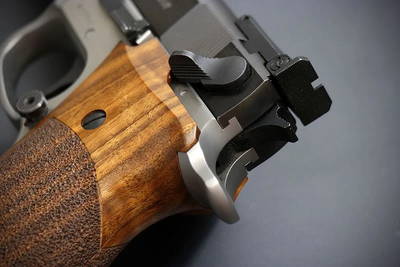
Why decock your pistol?
There are a few reasons why you might want to decock your pistol.
First off, carrying a pistol with the hammer down and a filled chambered may be more natural for some people. It also decreases the chances of an accidental discharge if the gun is dropped or mishandled.
Secondly, it is a safety measure. If you do not decock your gun, there is always the potential for an accidental discharge. This could happen if the gun is dropped or if something else hits the trigger.
Finally, decocking your gun will help prolong its life. Constantly cocking and uncocking the hammer can cause wear and tear on the gun over time. By decocking it when you are done shooting, you can help ensure that your pistol lasts for many years to come.
What pistols can you decock safely?
Decocking is a convenient way to safely carry a cocked pistol, and it's also a necessary step in field-stripping many pistols, but not all pistols can be decocked safely. Decocking a pistol is the process of manually lowering the hammer from the cocked position. This can be done with any pistol that has an exposed hammer, such as a 1911.
Striker-fired pistols, on the other hand, lack a hammer and can't be reliably decocked. That's not to say that you can't decock a striker-fired pistol, but doing so is more complicated and may require special tools or training. For example, on a Glock, you must first remove the magazine, then rack the slide to chamber a round. Once the round is chambered, you can press the trigger to release the striker and safely lower the slide.

Guide for proper pistol decock
Maintain the gun's sight in a safe direction.
Always point a gun in a safe direction. Maintain your gun pointing in a secure direction at all times. Since it is a general safety precaution, this is the first and foremost crucial weapon safety regulation. Decocking the hammer with the muzzle pointed in the right direction ensures safety even if everything else turns out badly!
Engage the safety, if possible.
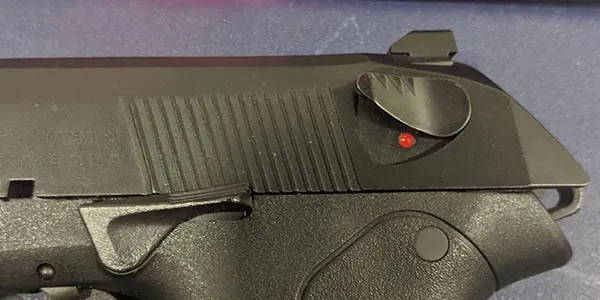
Next, engage all available outside safety devices, such as thumb safety or grip safety. This will help to prevent an accidental discharge if the gun is dropped or mishandled.
There may be inner or trigger safeties on some firearms. However, these are usually designed to prevent firing when the trigger is pulled and will not necessarily prevent an accidental discharge if the gun is dropped.
Remove your finger from the trigger.
Now that you have engaged all external safety devices, take your finger off of the trigger. This will help to prevent an accidental discharge while you are decocking the hammer.
Make use of decocking lever or decocker, if available.
The exact purpose of a decocker or decocking lever is to lower the hammer without firing a cartridge. It may be a separate lever or it may be built into the safety. The location and function of a decocker will vary depending on the make and model of your gun, so consult your owner's manual to learn how to use it properly.
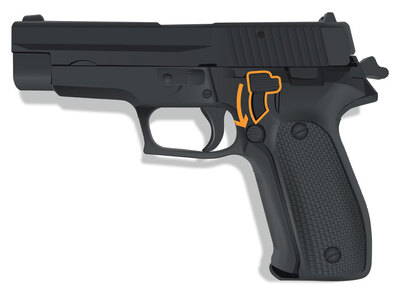
If there is no decocking lever, you can still safely lower the hammer by using the following method:
- With the muzzle pointed in a safe direction, hold the gun in one hand with your thumb extended over the top of the slide.
- Use your other hand to grasp the hammer firmly and pull it back until it locks in place.
- Now, press down on the hammer with your thumb while carefully releasing pressure on the trigger. The hammer should slowly lower itself down onto the firing pin without firing.
- Just follow the manufacturer's instructions on how to properly use these devices.
Put the thumb of the non-firing hand in front of the hammer.
With the muzzle pointed in a safe direction and your finger off the trigger, use your non-firing hand to support the hammer while you apply pressure to the back of it with your thumb.
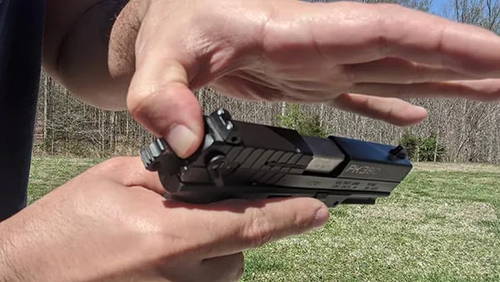
Or, you can press your thumbnail out against the hammer and seal your thumb firmly in place. Two simple reasons.
First, if your thumb is positioned carelessly, it could squeeze your flesh between the slide and the hammer.
Secondly, if the thumb is positioned carelessly, the force of the hammer may cause it to move, which could lead to a careless discharge.
Position the thumb of your shooting hand against the hammer.
This might be your final layer of protection to stop the hammer from accidentally running. Put your shooting hand's thumb on the upper edge of the hammer after positioning your non-shooting hand's thumb on the front of it.
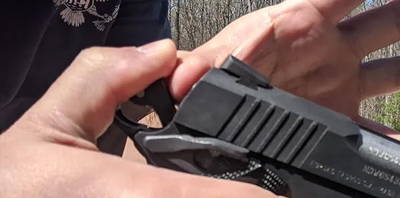
If you have a hitchhiker's thumb (a condition where the thumb can bend back to touch the palm), it may not be possible to grip the hammer firmly enough with your shooting hand.
In this case, you should use your non-shooting hand to support the hammer while you apply pressure to the back of it with your thumb. Each person embraces various body structures, so be flexible to support your weak points in time.
Keep the hammer down and carefully squeeze the trigger.
With the hammer down and your finger off the trigger, slowly and carefully squeeze the trigger. Doing so will release the tension on the hammer and allow you to lower it safely. It would be better to use a slow, controlled squeeze and apply pressure to the hammer with your shooting thumb.
The thumb on the hammer is used to regulate the rate of the hammer's descent. The hammer doesn't need to be entirely stopped; instead, its motion should be restricted.
Once you have lowered the hammer, remove your hand from the gun.
Now that you have successfully decocked your pistol, you can remove your hand from the gun.
As you slowly and carefully release pressure on the trigger, the hammer should fall down onto the firing pin without firing a cartridge. If it does not, recheck your safety devices and try again.
Are you having fun reading with Dinosaurized? Here's a little gift for better shopping experience~
Enter this 15% Discount code: "GundiscussionD15" at Checkout now~
How can people safely decock a 1911?
You must proceed with extreme caution. The following is how to go "best":
1. Pull back the hammer all the way without pressing the grip safety.
2. Pull the trigger without leaving the grip safety weaker than expected.
3. Release the trigger after slightly lowering the hammer with caution.
4. Release the trigger after slightly lowering the hammer with caution.
5. Last, gently lower the hammer.
Now, the benefit of doing this technique is that the gun won't fire since the hammer will stop well before the shell casing. To get it perfect, you must practice, so shoot empty first (empty chamber, empty pistol, no round, no magazine).
But in all truthfulness, the 1911 is meant to be held cocked and locked, with the safety engaged, the hammer back, the magazine fully loaded, and the round in the chambers. The grip safety at the back of the gun's grip handles the remaining functions once the physical safety has completed its task.
Another way for decocking: pinching
One other different technique for decocking a handgun, and it requires squeezing the hammer with the hand that isn't used to pull the trigger. Unlike the above method, in this one, you only use your non-dominant hand to stop a careless discharge.
This is what it looks like:
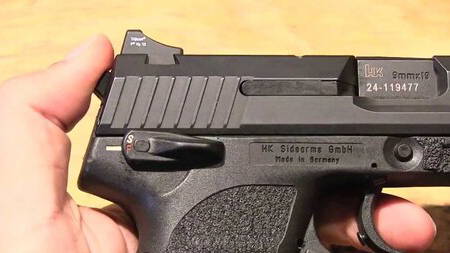
- With the muzzle pointed in a safe direction, hold the gun in your firing hand with your thumb extended over the top of the slide.
- Use your other hand to grasp the hammer firmly and pull it back until it locks in place.
- Now, use your non-firing hand to pinch the hammer between your thumb and forefinger while carefully releasing pressure on the trigger with your firing hand. The hammer should slowly lower itself down onto the firing pin without firing.
Decocking lever or manual safeties?
Just keep in mind that certain pistols can come with a manual safety or a decocking lever before we continue. If you are uncertain about using these functions rather than manual decocking a pistol that has them, just do it.
Similar to single-action semi-auto handguns, many double-action semi-automatic pistols have manual safeties.
They must be disengaged, just like a single-action handgun, in order to strike, but they can be lowered to a double-action state, which is an advantage of the safety when choosing between a handgun with a decocker or mechanical safety.
Which is better?
Truth be told, there are lots of DA guns out there that don't have manual safety and are perfectly safe to carry, and vice versa.
While a decocker is convenient, it's not as safe as manual safety. A decocker can be inadvertently disengaged, which could result in an accidental discharge if the trigger is pulled. A manual safety, on the other hand, must be deliberately disengaged in order to fire the gun. This makes it much less likely that the gun will fire accidentally.
It can seem odd to put a manual safety on a double-action handgun. Still, using a manual safety has certain advantages for those who would like to OWN one.
On a DA semi-auto, the hammer is obviously cocked when the slide is racking. The pistol can then be kept cocked and locked like a 1911 or BHP if the owner so decides. The handgun can be put on safe in double-action mode and the hammer mechanically lowered, much like with a decocking safety, if the user so chooses.

If you're trying to decide between a handgun with a decocker or one with manual safety, it's important to consider how the gun will be used.
If the gun will be carried for self-defense, manual safety is probably the better choice. If the gun will be used for target shooting or plinking, a decocker may be more convenient.
Only if you're going to cock the pistol before firing, which you may not have enough time to do before shooting in an emergency, a decocker or decocking safety necessitates a double-action initial shot. A decocking pistol is likely not the ideal choice for you if you are not skilled with a DA trigger or are unwilling to invest the time to improve. In that scenario, a manual safety is preferable because you can carry it cocked and locked without worrying.
The concern is how much safety mechanism you feel okay with if you don't bother the DA trigger. Some folks prefer to have a safety device while others don't want to take the possibility that it will slow them down should they need to draw their weapon.
Remember, whether you have a decocker or manual safety, always treat every gun as if it can fire at any moment. Never point the gun at anything you don't want to shoot, and always keep your finger off the trigger until you're ready to shoot. By following these basic rules of gun safety, you can avoid accidental shootings with no matters.
Conclusion
Whether you’re a first-time gun owner or an experienced marksman, it’s important to know how to safely and effectively decock your pistol. By following our guide or watching one of the many online videos demonstrating the process, you can ensure that you and those around you stay safe when handling firearms.
Remember to always practice firearm safety procedures whenever possible, and be sure to keep up with your shooting skills; after all, practice makes perfect!
Are you having fun reading with Dinosaurized? Here's a little gift for better shopping experience~
Enter this 15% Discount code: "GundiscussionD15" at Checkout now~

